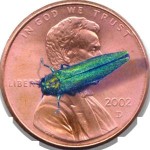All Bugs Good & Bad Webinar Series- Fire Ant Management Using Baits
Blog post by Mrs. Wizzie Brown
When: Friday, March 6, 2015 at 1PM CST
Link: http://connect.extension.iastate.edu/fireant
Cost: FREE
Learn how to make the biology of fire ants work for you not against you. This webinar presented by Dr. Lawrence “Fudd” Graham from Auburn University will discuss fire ant baits and other control methods. It will also provide the latest information on the Pseudacteon phorid flies, natural enemies of fire ants. Moderated by Dani Carroll and Bethany O’Rear, Regional Extension Agents, Alabama Cooperative Extension System, and Vicky Bertagnolli-Heller, Extension Agent and Master Gardener Coordinator, Clemson University. Click here to login as a guest and participate in the live event. Note: on March 6, the link to the live webinar opens about 15 minutes before the webinar. If you log in earlier, you will get an error message.
For more webinars in this series, see All Bugs Good and Bad 2015 Webinar Series. The webinars are brought to you by the following eXtension Communities of Practice: Imported Fire Ants, and Urban IPM; and by the Alabama Cooperative Extension System and the University of Georgia Center for Urban Agriculture.
If you missed the previous webinar on Pesticide strategy- the good, the bad the ugly, you can still view it from the link below by clicking Watch recording in the top right corner.
https://learn.extension.org/events/1864#.VOdGJCzcBNg
Borer gets a little closer
Blog post by Dr. Mike Merchant
What’s shiny and Godzilla green, easily fits on a penny, and has resulted in the death of tens of millions of trees over the past dozen years? If you’ve been paying attention to this blog, you might guess the emerald ash borer (EAB). Over the past few years my colleagues and I have been involved with a monitoring project designed to detect the first EAB entering north Texas. During this time I’ve watched the beetles inch closer to Texas–moving from its initial point of invasion in Michigan throughout the Ohio River valley and eventually into Missouri, Kansas and Colorado, and, last summer, in six counties in southern Arkansas.
Earlier this month, on a hunch, some zealous U.S. Forest Service employees examined a likely ash stand of 12-15 trees outside of Pineville, LA. On Feb 10, entomologist James Zablotny, emerald ash borer identification specialist for USDA, APHIS, PPQ in Romulus, Michigan, confirmed that three larvae collected from the trees were indeed EAB. The collection site was just inside the Louisiana border, about 9 miles east of Springhill, LA, in Webster Parish.
These latest finds put the EAB within 40 miles of Texas, and suggest that we in Texas may be next, if the beetle isn’t here already.
So how is this beetle with stubby wings getting so close so fast? With the help of man, no doubt. Experts believe that the most common way that this beetle finds its way across state lines is in firewood. Campers, sportsmen, or firewood vendors cut up borer-infested trees and put them on a vehicle and give the hitchhiking insects a lift.
What does this mean to owners of ash trees? Since the nearest infestations are approximately 40 miles away

Emerald ash borer larva and damage under the bark of white fringetree, a new host of this pest. Image from D. Cipollini, J of Economic Entomology, Feb 2015
from our state, nothing yet. However, experience from other states suggests that owners of valuable ash trees within 15 miles of a known infestation should consider proactive treatment of their trees with a labeled insecticide.
In a few weeks our office, along with entomologists from the Texas Forest Service and Sam Houston State University, will start the 2015 Texas EAB survey. This is something we’ve been doing for over five years, but this year takes on extra meaning with the threat known so close to our border.
More bad news
As if we needed more bad news, in addition to ash (trees in the genus Fraxinus), the EAB has now been found to attack white fringe tree, Chionanthus virginicus, a native tree species that is also used sometimes as an ornamental plant. In an article published in the Journal of Economic Entomology this month, Dr. Don Cipollini of Wright State University in Ohio presented the first evidence that EAB might attack other plants in addition to ash. Although fringetree is a relative of ash, the possibility exists that a few other, native plant genera closely related to Chionanthus might be susceptible to this pest.
While maybe not as destructive as Godzilla, I have no doubt we will learn to respect this pest. More on symptoms and different management options in later posts.
AgriLife Extension modules help students learn about nature
By Paul Schattenberg
If your child’s response to the old joke, “Why did the chicken cross the road?” is “What’s a chicken?” then he or she would benefit from educational modules available from the Texas A&M AgriLife Extension Service, according to Nora Tapia, the agency’s youth outreach coordinator for Bexar County.

The City Critters learning module introduces urban
kids to some of the needs and habits of wildlife they may encounter. (Texas A&M AgriLife Extension Service photo)
Tapia said the modules are available through the Wildlife Module Curriculum Enrichment Program of the agency’s 4-H Youth Development program.
“Data collected by AgriLife Extension from elementary school teachers throughout Texas show children in this grade have limited knowledge of wildlife and resource conservation,” Tapia said.
Currently about 80 percent of Texans live in urban areas such as San Antonio, she said, and while young people support protecting the environment, they have a poor understanding of environmental issues and how ecosystems work.
“To help urban youth better understand the natural environment, AgriLife Extension has developed museum-quality educational modules and made them available to elementary and middle schools,” Tapia said.
The modules, which target mainly third through seventh-grade students, are comprised of hands-on displays, interactive computer programs, videos, lesson plans and printed information on renewable natural resources, urban-dwelling wildlife, aquatic ecology and water issues.
The modules are:
- City Critters — A multimedia module consisting of an 8-by-10-foot pop-up and static animal display. This module addresses the role of wildlife conservation and importance of natural resources management, along with increasing awareness of urban wildlife species.
- Something’s Fishy — A multimedia module with information on aquatic science, aquaculture, sport fishing, water quality and water conservation. The module consists of a 3-by-8-foot 3D display with full-size fish replicas, interactive CD, lesson activities, videos and water test kits.
- Wildlife Success Stories and Endangered Species — A multimedia module focusing on wildlife species recovered through proper environmental management and the status and recovery efforts toward currently endangered species. It consists of an 8-by-8-foot display, interactive CD, videos and lessons.
- Predators in the Classroom – This module addresses the biological and social impact of animal predators, such as coyotes and mountain lions, found in Texas.
Modules can be requested by educators for two-week periods throughout the year. Host

The Wildlife Success Stories and Endangered Species educational module focuses on positive outcomes in wildlife preservation and the need for people to give some animal species a helping hand toward survival. (Texas A&M AgriLife Extension Service photo)
teachers give instruction for the module curriculum and are provided with an instructional binder. A description of each module is given, along with a response form that may be printed and submitted to schedule the units.
For more information, go to http://wildlife.tamu.edu/publications/extension-education-programs/ and look under the “4-H School Enrichment Module” tab.
Tapia said Wildlife Success Stories and Endangered Species, City Critters and Something’s Fishy modules were sponsored jointly by AgriLife Extension and by the Texas Wildlife Association. City Critters received initial funding through the International Paper Foundation, the Renewable Resources Extension Act of the U.S. Department of Agriculture’s Cooperative State Research, Education and Extension Service, and the U.S. Fish and Wildlife Service.
“We’ve used the endangered species and City Critters modules and currently have the City Critters module on display in the science lab,” said Lisa Rollins, science specialist for kindergarten through fifth grade at Ed Cody Elementary School in San Antonio. “The kids like to see the representative animals in the display and they like the flexibility of watching videos, reading the guide and having other ways to learn using the module components.”
She said teachers from several second-grade classes with a total of about 120 students allowed their students to interact with the Wildlife Success Stories and Endangered Species module as part of their science instruction. About 125 fifth-grade students have already interacted with the City Critters module so far.
Pre- and post-test methodology is used to measure the educational impact of these modules, which provide curriculum enrichment in the areas of math, science, language, reading and other subjects in keeping with state-mandated requirements, Tapia said.
“Currently, there are more than 2,000 students from Bexar County elementary and middle schools who benefit annually from using these educational modules,” she said. “We would like to get even more schools, teachers and students involved in this curriculum enrichment program, so we’re looking for additional funding to update the modules and expand our reach.”
For more information, contact Tapia at 210-467-6575 or Nora.tapia@ag.tamu.edu.



 .
.